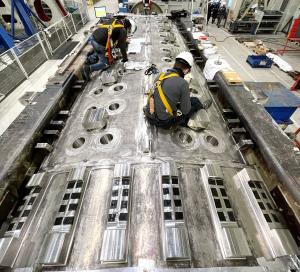Fitting the pieces virtually
A "virtual fit" tool developed by the European Domestic Agency is helping the vacuum vessel manufacturing team anticipate the challenge of final assembly—the moment when four sub-segments are brought together and welded to form the final 440-tonne sector. By visualizing alignment challenges and eventual clashes or gaps, the team is saving time and reducing risk.
Each D- shaped ITER vacuum vessel sector is an assembly of four smaller manufactured pieces—the inboard, upper, equatorial and lower poloidal segments. In the final production stage, the completed segments, which weigh approximately 100 tonnes each, must be brought together on an assembly platform to be aligned within exacting tolerances and welded.
With only millimetres to spare and huge components to be adjusted by crane, the operation is a challenging one. For vacuum vessel sector #5—the first in the European series—Fusion for Energy has introduced a virtual tool that takes metrology data from the completed segments and fits them together virtually, in advance of the actual operation.
The tool is capable of generating a simulation based on more than 1 million surveyed points, and highlighting various interface zones. By simulating different alignment scenarios, the contractors are able to arrive at the best and most optimized fit solution.
"It helps project managers to minimize risks and have a precise control of the assembly," explains Fusion for Energy metrology expert Alessandro Lo Bue, who worked with colleague Edoardo Pompa (SETIS Groupe Degaud) to build the methodology for virtual fitting from specialized software (SpatialAnalyzer®).
The tool has been in use for vacuum vessel sector #5 since November 2020.
See a report on the Fusion for Energy website here.


